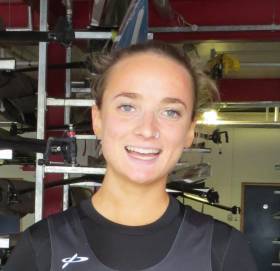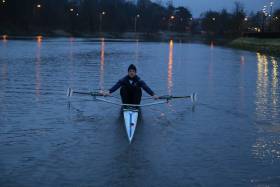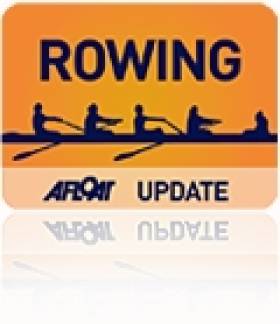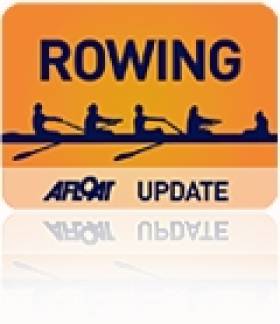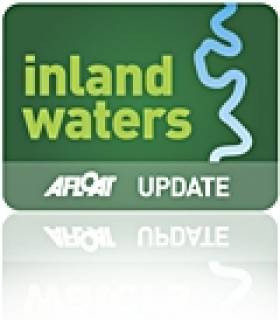Displaying items by tag: Portadown
Juniors Shine at Skibbereen and Portadown
Cremen and Fintan McCarthy Win at Skibbereen Regatta
#Rowing: Skibbereen had a one-two-three in the men's single sculls at their own regatta at the National Rowing Centre today. Gary O'Donovan, who was returning to racing after a hand injury, won his heat, but finished second to Fintan McCarthy in the final, with Aodhan Burns third. Paul O'Donovan was absent because of exam pressures.
UCC's Margaret Cremen won the women's single, while Holly Davis of Lee Valley, a junior 14 competitor, finished an excellent third. Sanita Puspure, whose boat had not made it back from the training camp in Italy, missed the event.
A tricky wind made conditions difficult, although this improved as the day went on.
The pairs titles were claimed by proven internationals: Mark O'Donovan and Shane O'Driscoll and Aifric Keogh and Monika Dukarska.
Brian Colsh of Sligo and Shauna Murtagh of Carrick-on-Shannon came out on top in the junior 18 single sculls at Portadown. The junior 16 eights titles, boys' and girls', went to Enniskillen RGS.
The Ulster Architectural Heritage Society will bring the Heritage Angel Awards to Northern Ireland for the first time and IWAI Newry and Portadown have been shortlisted to receive a Heritage Angel Award in the category Best Rescue, Recording or Interpretation of a Historic Place. On learning of the group's success Peter Maxwell the Branch treasurer said: "It's a huge honour for us to have won through the nomination process and we are looking forward to the decision. It's a great opportunity for us to spread the word about the canal and what a fantastic asset it is to the community."
IWAI Newry and Portadown volunteers have created a video entitled ‘New Life for the Old Canal’ that celebrates the project to re-water the summit level of the Newry Canal, a four mile stretch of water from Poyntzpass to Scarva. New lock gates were built and installed by the volunteers to allow canoes and small boats to use the canal. Alongside this the group researched and published a guided walk app highlighting the history of the canal. They also manage a heritage centre on the towpath with displays to help visitors understand how a canal works and how its restoration could help boost the local economy.
The purpose of the Heritage Angel Awards is to recognise groups that inspire and increase activity to help conserve and protect built heritage, a purpose that according to Peter, IWAI Newry and Portadown volunteers support very strongly; "We certainly meet that aim as our volunteers contribute more than 2000 hours annually to canal projects. Without our input it's fair to say that the canal, dating from 1742 and the first of its kind in Ireland & the UK would again become a neglected, overgrown ditch as was the case when it was abandoned in 1949. Instead, our project on the summit has shown how the canal can be used by many different types of people for recreation and enjoyment."
Peter’s enthusiasm and that of his fellow volunteers clearly shows the potential impact that a project like this can have on society as a whole. Please show your support and cast your vote now to show that there most definitely is new life for the old canal. Logon to https://www.heritageangelawards-ni.org.uk/ Voting closes on Friday October 27th. The awards ceremony will take place in the Grand Opera House, Belfast on Tuesday November 7th. The Awards are funded by the Andrew Lloyd Webber Foundation and the Department for Communities.
Belfast RC and UCD join Hosts in Taking Titles at Portadown
#Rowing: Portadown had an excellent day at their own regatta, taking the men’s Club One eights final. Bann, who also did very well, took the women’s club two eight. Belfast Rowing Club took the women’s senior quadruple title and UCD the men’s club one coxed quadruple. On a day where the wind became an increasingly important factor, some of the junior 14 and junior 15 events had to be cut.
Portadown Regatta (Selected Results)
Men
Eight – Club One: Portadown bt RBAI 4l. Jun 16: RBAI bt CGS ¾ l. Masters: Neptune (D) bt BRC A (E) easily.
Four – Masters, coxed: Belfast RC B (F) bt Belfast RC (D)
Sculling, Quadruple – Club One, coxed: UCD bt RBAI 5l. Novice, coxed: Newry bt RBAI 4l. Jun 18A: Portadown B bt Portadown A 3l. Jun 16, coxed: Bann bt Portadown 2¼ l.
Double – Club One: Portadown B bt UCD B 2½ l. Jun 18A: Portadown A bt Portadown B 3l. Jun 16: Bann bt Portadown 3l. Masters: City of Derry (D) bt Portadown (E) 1½ l.
Single – Inter: UCD (Earley) bt Portadown (Laivins) 1½ l . Club One: Carrick (Earley) bt Bann (Christie) 1 ft. Nov: City of Derry (Begley) bt RBAI (Gowdy) dist. Jun 18A: Portadown (Hull) bt CGS (Moore) 4l. Jun 16: Portadown (Pinkerton) bt Bann (O’Donovan) 2¼ l. Masters: City of Derry (D’Urso; E) bt Portora (Murphy; E) ½ l.
Women
Eight – Club Two: Bann bt Neptune 1l.
Four – Masters, coxed: BBC (E) bt BRC B (C) 5l.
Sculling, Quadruple – Sen: BRC bt Carrick 6l. Club One, coxed: Portadown bt Belfast BC 6l. Jun 16, coxed: Bann bt Portadown A 5l. Masters: Belfast BC (E) bt Portadown (C) 6l.
Double – Club One: Portadown bt Belfast RC ¾ l. Jun 18: Belfast RC bt Belfast BC 5l. Jun 16: Bann B bt Bann C 3l. Masters: Lagan (C) bt Portadown (C) dist.
Single – Sen: Bann (O’Donovan) bt Portadown (Kells) 6l. Club One: Bann (O’Donovan) bt Portadown (Canniford) dist. Jun 18A: Bann (Carson) bt Carrick-on-Shannon (Duggan) 3 ft. Jun 16: Bann (Breen) bt Neptune (Clarke) dist.
Doyle is Afloat Rower of the Month for February
#Rower of the Month: Philip Doyle of Queen’s University is the Afloat Rower of the Month for February. The big medical student was the fastest single sculler at the Lagan Scullers’ Head of the River. He covered the course in under 12 minutes and had just over 17 seconds to spare over Portadown’s Sam McKeown.
Rower of the Month awards: The judging panel is made up of Liam Gorman, rowing correspondent of The Irish Times, and David O'Brien, editor of Afloat magazine. Monthly awards for achievements during the year will appear on afloat.ie and the overall national award will be presented to the person or crew who, in the judges' opinion, achieved the most notable results in, or made the most significant contribution to rowing during 2016. Keep a monthly eye on progress and watch our 2016 champions list grow.
Doyle Best Single Sculler at Head of the River in Belfast
#Rowing: Philip Doyle of Queen’s University won the battle of the senior single scullers at the Lagan Scullers’ Head of the River in Belfast. He had just over 17 seconds to spare over Portadown’s Sam McKeown. The fastest crew on the day was the Queen’s University senior men’s quadruple. The event was run in strong winds, but coming from the east, they did not prove to be seriously disruptive. The organisers were pleased that the Ireland under-23 women's group took part and that some junior scullers could compete, as their trials had been cancelled.
Lagan Scullers’ Head of the River, Belfast, Saturday (Selected Results):
Race One
Overall: 1 Queen’s Univ (P Doyle, senior single sculls) 11 minutes 56.2 seconds. 2 Portadown (S McKeown, senior single) 12:13.3, 3 Queen’s (T Oliver, senior single) 12:15.9.
Men – Sculling, Quadruple – Jun 15, coxed: Portora 12:40.5
Double – Jun 16: Portora 13:04. Masters: City of Derry 13:29.8.
Single – Senior: Queen’s (Doyle) 11:56.2. Jun 18A: Methody (C Macrae) 12:47.2
Women – Sculling – Quadruple – Masters: Lagan Scullers/Belfast BC 15:01.8.
Double – Jun 18A: Bann 12:55.8.
Single – Intermediate: Belfast BC (O Blundell) 14:09.3. Club Two: Queen’s (R Brown) 15:01.1. Jun 16: Belfast RC (A Hall) 16:05.8.
Race Two
Overall: 1 Queen’s men’s senior quadruple (Roy) 10:43.6, 2 RBAI men’s sen quad 11:14.1, 3 Queen’s men’s sen quad (Evans) 11:31.0.
Men – Sculling, Quadruple – Senior: Queen’s (Roy) 10.43.6. Jun 16, coxed: Methody 11:56.5.
Double – Jun 18A: Bann 11:51.
Single – Intermediate: Portora (C Laughlin) 12:33.7. Club Two: Belfast RC (T McCaughtry) 12:51.4. Novice: RBAI (T Lyons) 14:57.3. Jun 15: Portora (O Donaghy) 13:59.4.
Women – Quadruple – Jun 16, coxed: Portora 13:44.4. Jun 15, coxed: Bann 14:10.8.
Double – Seniors: Fermoy/Belfast BC 12:53.7.
Single – Jun 18A: Bann (H Scott) 13:45.2. Masters: Belfast BC (U Purdy) 15:15.6.
Race Three
Overall: 1 Methody junior 18A quadruple 10:43.1, 2 Queen’s senior double 10:57.4, 3 Belfast BC, Portadown 11:18.4.
Men, Quadruple – Jun 18A: Methody 10:43.1. Jun 18B, coxed: Methody 12:18.5.
Double – Senior: Queen’s 10:57.4.
Single – Jun 16: Portora (N Timoney) 13:40.1. Masters: Portora (D Murphy) 13:40.8.
Women, Quadruple – Jun 18A: Methody 12:48.6
Double – Jun 16: Bann 14:50.9.
Mixed Quad – Portadown 13:40.2.
NUIG/Grainne Mhaol Four See Off Strong UCC Challenge
#ROWING: UCC gave them a good race, but NUIG/Grainne Mhaol moved away in the closing stages to prove themselves the top men’s four at Cork Regatta. The experience of Sean Jacob and Dave Neale also told in the men’s double scull, with the Ireland under-23 double of Sam McKeown and Andrew Griffin had to give way to the Old Collegians men. The women’s four and double went to young Skibbereen crews: Aoife Casey and Emily Hegarty, who are both 16, were part of the winning four and then switched into the double and won again.
Cork Regatta, National Rowing Centre (Selected Results)
Sunday
Men
Four – Div One – A Final: 1 NUIG/Grainne Mhaol (sen) 6:07.807, 2 UCC A 6:10.83, 3 Carlow (sen) 6:15.543. Four, coxed – Div Two – A Final: Skibbereen (Club Two) 6:43.837. B Final: Trinity (Club Two) 7:04.517; 3 Col Iognaid (jun 16) 7:06.357.
Sculling
Double – Div One – A Final: 1 Old Collegians (D Neale, S Jacob; sen) 6:29.50, 2 Portadown/Skibbereen (sen) 6:34.43, 3 Shandon (jun 18A) 6:44.873. B Final: Waterford (inter) 6:46.473. C Final: Lee (inter) 6:48.227; 4 Methody (Club One) 7:10.627.
Single – Div Two – A Final: Belfast BC (A Murray; jun 18B) 7:35.483, 2 Cappoquin (Aherne; club two) 7:5.052; 4 Lee (Jackson, jun 16) 7:49.427. B Final: Clonmel (Dundon; jun 16) 7:49.347. C Final: St Michael’s (O’Byrne; jun 16) 7:48.40.
Women
Four – Div One – A Final: 1 Skibbereen (jun 18A) 7:08.330, 2 Shannon (sen) 7:12.137, 3 Skibbereen (sen) 7:27.62.
Sculling
Double – Div One – A Final: 1 Skibbereen (A Casey, E Hegarty; jun 18A) 7:28.957, 2 Lee (jun 18A) 7:33.43, 3 St Michael’s (inter) 7:43.430. B Final: Belfast BC A (inter) 7:39.570.
Pre-Race Crash Rules Out Queen's at Lagan Head of the River
# ROWING: A collision before the start between the Queen’s University senior eight and the Portadown intermediate four took both crews out of the reckoning at the second head of the day at Lagan Head of the River in Belfast on Saturday. One of the Portadown crew had to be treated in hospital. In the absence of Queen’s, Neptune’s junior 18 eight ruled the waters: they took pennants as fastest crew; fastest junior crew and fastest junior 18 eight. The Belfast Boat Club/RBAI senior crew was the fastest four and Trinity's top women’s senior eight placed well.
| Lagan Head of the River 2013 - Race 2 – 4200m Saturday 16th February at 1500 |
|---|
| RESULTS by Time – Masters handicap not applied |
| POSITION |
| CREW |
| NUMBER Club Class Cox/Steerer Time % of winning |
| time Comments |
| 1 6 Neptune RC MJ18A 8+ H. Thompson 15:59.2 100.00 |
| 2 5 Portora BC MJ18A 8+ E. McClean 16:02.9 100.39 |
| 3 2 CAIBC MJ18A 8+ M. Bucklee 16:03.7 100.48 |
| 4 8 BBC/RBAIRC MS 4- A. Boreham 16:12.1 101.35 |
| 5 21 QUBBC A MN 8+ P. Ramsey 16:36.1 103.85 |
| 6 11 DULBC A WS 8+ G. Nic Fhionnain 16:43.1 104.58 |
| 7 20 BRC MN 8+ K. McCullagh 16:48.2 105.11 |
| 8 13 BBC MM E 8+ A. Scott 17:06.2 106.99 |
| 9 7 LSC MS 4X- P. Cross 17:10.8 107.46 |
| 10 31 Bann RC MJ16 8+ D. Tang 17:11.1 107.50 |
| 11 12 DULBC B WS 8+ N. Williams 17:12.4 107.63 |
| 12 4 RBAIRC MJ18A 8+ R. Hulatt 17:15.8 107.99 |
| 13 22 QUBBC B MN 8+ S. McGaughey 17:27.6 109.21 |
| 14 10 CAIBC/Portora BC MS 4- S. Archibald 17:32.3 109.71 |
| 15 14 BRC/BBC MM E 8+ S. Mairs 17:38.8 110.38 |
| 16 25 BRC MM C 8+ U. Smart 17:54.7 112.05 |
| 17 15 OCBC/Three Castles RC MM F 8+ J. Henry 18:05.4 113.16 |
| 18 27 QUBLBC WI 1 8+ C. Moorehead 18:09.1 113.54 |
| 19 28 Bann RC WI 1 8+ L. Ferguson 18:24.4 115.15 |
| 20 17 CAIBC MI 1 4+ A. Stewart 18:47.7 117.56 |
| 21 23 LVBC MM F 8+ M. Warnock 18:53.3 118.15 |
| 22 40 QULBC A WN 8+ C. Campbell 19:00.2 118.87 |
| 23 37 Portora BC A WJ18A 8+ Z. Donaldson 19:00.5 118.91 |
| 24 24 Bann RC MM C 8+ E. Earl 19:20.1 120.94 |
| 25 42 DULBC A WN 8+ K. Paterson 19:20.9 121.03 |
| 26 32 CAIBC MJ16 8+ A. Stewart 19:26.5 121.61 |
| 27 29 BRC WI 1 8+ E. Catterall 19:42.1 123.24 |
| 28 30 BBC WM D 8+ H. Wilson 19:46.9 123.74 |
| 29 45 DULBC B WN 8+ N. O'Sullivan 20:34.0 128.66 |
| 30 26 BBC/LSC WS 4X- S. Herron 20:54.1 130.75 |
| 31 46 QULBC C WN 8+ M. Toner 20:55.4 130.89 |
| 32 33 Portora BC MJ16 8+ J. Foster 20:57.0 131.05 |
| 33 44 QULBC B WN 8+ A. Espona-McCartney 21:17.2 133.16 |
| 34 36 Portadown BC MM D 8+ R. Walker 22:01.4 137.76 |
| 35 43 Portora BC WN 8+ C. McClean 22:05.7 138.21 |
| 36 35 QUBLBC WS 4- A. Aitken 22:07.6 138.41 |
| 37 39 BRC WM E 8+ S. Smith 22:38.2 141.60 |
| 38 38 Portora BC B WJ18A 8+ E. Reynolds 22:41.3 141.92 |
| 1 QUBBC MS 8+ A. Margret |
| 9 BRC MS 4- C. Coyle |
| 16 QUBBC MI 1 4+ R. Crowley |
| 18 Portadown BC MI 1 4+ L. Chambers |
| 19 BBC WS 4X- L. Cameron |
| 41 UCDBC WN 8+ V. Turner |
| Lagan Head of the River is organised by Belfast Rowing Club |
| with assistance from Queens University Boat Club, Lagan Scullers Club, RBAI |
| Rowing Club and Belfast Boat Club |
| and the following organisations – |
| Belfast Harbour Commissioners |
| Belfast City Centre Regeneration Directorate |
| Odyssey Arena |
| Police Service of Northern Ireland |
| Powerhouse Sport |
Shillington's Quay in Portadown Set for Revamp
Shillington's Quay in Portadown is set for redevelopment thanks to a significant grant from the European Union.
The Portadown Times reports that half of the borough's £200,000 (€230,000) funding will be used for a new floating jetty and environmental improvements for the Newry Canal quay area, which was last used as a working port in the 1930s.
A total of £2.5 million (€2.9 million) has been earmarked by the EU for promoting tourism in the cross-border East Border Region, which aside from six Northern Ireland council areas also includes the Irish counties of Louth, Meath and Monaghan.
Other improvements to marine and waterway facilities include a £125,000 (€145,000) investment for the Eisenhower Pier in Bangor, on the southern side of Belfast Lough.
The Portadown Times has more on the story HERE.


























